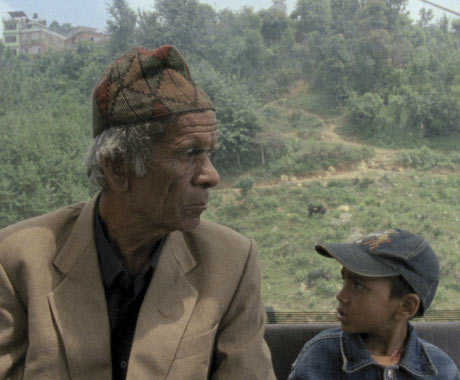Although technically classified as a documentary, Manakamana is less like a film and more like a moving piece of poetry.
Produced by the Harvard Sensory Ethnography Lab — an experimental laboratory that uses analog and digital media to harness the sounds and visual stimuli of different cultures for foreign viewers — the film documents a group of pilgrims as they travel via cable car to worship at Manakamana, a temple that is located 4,272 feet above the jungles of Nepal.
Using a fixed camera located at one end of a cable car, directors Stephanie Spray and Pacho Velez capture the sights, sounds, awkward glances and conversations of a few sets of passengers (and one unruly group of goats) over the eight-and-a-half-minute cable car ride, fully immersing viewers in the commute while never allowing them to see the full scope of its surroundings. In doing so, Spray and Velez present a unique character study that fully redefines what a traditional documentary can be.
While Manakamana may not function as a normal narrative, it still presents a few interesting ideas about the pitfalls and powers of globalization. The cable car is a relatively new phenomenon for those travelling to Manakamana, having only been opened for use in 1998 (and imported from Austria). Because of this, older passengers captured on film spend much of the trip in pure silence, soaking in the awe-inducing countryside while occasionally discussing the daylong hikes it used to take to get there back in the day. On the other side, younger passengers (including a group of metalheads, who strangely bring a kitten along for the ride) spend most of their time talking about nothing in particular, snapping photos of one another with their digital cameras, while wondering why someone would even attempt such a journey on foot.
It's that separation of old and new that provides the crux of Manakamana, as Spray and Velez document the country's cultural shift towards the easy enjoyment and comforts usually associated with a westernized lifestyle (i.e. making a spiritual pilgrimage without ever having to lift a foot) while alternately overloading viewers senses with the sights and sounds of a simple cable car ride.
It may not sound as hard-hitting as other documentaries (after all, this is a film in which the biggest bout of excitement comes halfway through, when the camera switches from documenting the ride up to documenting the ride down), but the strength of Manakamana lies in its excruciatingly beautiful portrayal of a community and culture at odds with its progression into a globalized society.
(Films We Like)Produced by the Harvard Sensory Ethnography Lab — an experimental laboratory that uses analog and digital media to harness the sounds and visual stimuli of different cultures for foreign viewers — the film documents a group of pilgrims as they travel via cable car to worship at Manakamana, a temple that is located 4,272 feet above the jungles of Nepal.
Using a fixed camera located at one end of a cable car, directors Stephanie Spray and Pacho Velez capture the sights, sounds, awkward glances and conversations of a few sets of passengers (and one unruly group of goats) over the eight-and-a-half-minute cable car ride, fully immersing viewers in the commute while never allowing them to see the full scope of its surroundings. In doing so, Spray and Velez present a unique character study that fully redefines what a traditional documentary can be.
While Manakamana may not function as a normal narrative, it still presents a few interesting ideas about the pitfalls and powers of globalization. The cable car is a relatively new phenomenon for those travelling to Manakamana, having only been opened for use in 1998 (and imported from Austria). Because of this, older passengers captured on film spend much of the trip in pure silence, soaking in the awe-inducing countryside while occasionally discussing the daylong hikes it used to take to get there back in the day. On the other side, younger passengers (including a group of metalheads, who strangely bring a kitten along for the ride) spend most of their time talking about nothing in particular, snapping photos of one another with their digital cameras, while wondering why someone would even attempt such a journey on foot.
It's that separation of old and new that provides the crux of Manakamana, as Spray and Velez document the country's cultural shift towards the easy enjoyment and comforts usually associated with a westernized lifestyle (i.e. making a spiritual pilgrimage without ever having to lift a foot) while alternately overloading viewers senses with the sights and sounds of a simple cable car ride.
It may not sound as hard-hitting as other documentaries (after all, this is a film in which the biggest bout of excitement comes halfway through, when the camera switches from documenting the ride up to documenting the ride down), but the strength of Manakamana lies in its excruciatingly beautiful portrayal of a community and culture at odds with its progression into a globalized society.
